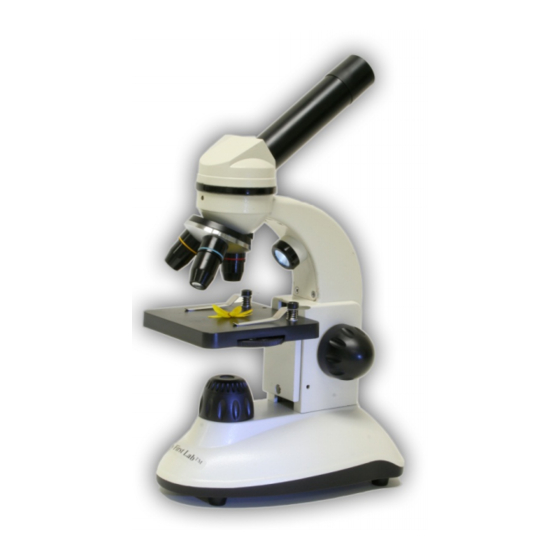
Table of Contents
Advertisement
®
™
DUO SCOPE
USER MANUAL
Model MFL-06
This microscope is intended for use by ages 9 and older.
Parents are reminded this is a scientific tool and contains glass microscope slides and sharp instruments.
Proper Handling and parental supervision is required.
.
Always follow the appropriate safety procedures
Advertisement
Table of Contents

Summary of Contents for My First Lab DUO SCOPE MFL-06
-
Page 1: User Manual
My First Lab ® ™ DUO SCOPE USER MANUAL Model MFL-06 This microscope is intended for use by ages 9 and older. Parents are reminded this is a scientific tool and contains glass microscope slides and sharp instruments. Proper handling and parental supervision is required. -
Page 3: Specifications
LED illumination that provides both sub-stage and overhead lighting. Battery power eliminates the need for electricity or power cords and allows for portable use “in the field”. The My First Lab ® combines two separate applications into one fantastic package that SCOPE™... - Page 4 Components Study the picture below to become familiar with the different parts of your microscope.
- Page 5 Accessories is equipped with the following accessories: My First Lab ® DUO SCOPE™ 1. 5 Plain Slides 2. 1 Concave Slide 3. 4 Prepared Slides 4. Cover Glass 5. Plastic Transfer Pipet 6. 2 Bottles of Non-Toxic Stain (Red & Blue) 7.
- Page 6 Maintenance To prolong the life of your batteries, turn off the power immediately when not in use (be sure all lights are off—switch in the center position.) Dust the unit with a soft dry cloth or soft brush. Fingerprints and debris may be removed with a damp cloth.
- Page 7 7. Should this product cause, or be affected by, local electrical interference, move it away from other electrical equipment. Reset (switching off and back on again or removing and re-inserting batteries) if necessary. 8. RECHARGEABLE BATTERIES: Do not mix these with any other types of battery.
- Page 8 The My First Lab has the capability to illuminate the ® DUO SCOPE™ specimen from the top (stereo microscope) or the bottom (compound microscope).
- Page 9 image of the specimen becomes clear. Be careful not to let the slide touch the lens. Focusing Tip While focusing, if the stage stops moving, DO NOT FORCE IT. You may damage the microscope. The disc diaphragm, located directly below the stage, has six different apertures (openings), which allow various amounts of light to pass through.
- Page 10 Compare to a flat field, such as a postage stamp, where the specimen is all at the same level which allows the microscope to focus on the entire field. With a little practice, you can soon become an expert at observing all types of specimens with the My First Lab ® SCOPE™.
- Page 11 Ideas for Observation Children: Always get an adult’s permission before trying any experiments! 1. Crystals: Place a few grains of dry salt or sugar on a slide to observe. Mix salt with a spoonful of warm water in the test tube and then use the plastic transfer pipet to place a couple drops on a plain slide.
- Page 12 Insect Observation Below are some screen shots to compare the wings of several different insects. Notice the difference in the shape and structure. Use your microscope to compare other similar common household items. Mosquito Wing Fly Wing Honeybee Wing (40X Magnification) (40X Magnification) (40X Magnification) Mold Growth Observation...
- Page 13 Mitosis in Onion Cells Mitosis is part of the cell cycle when replicated chromosomes are separated into two new nuclei. Observation Steps 1. With an adult’s supervision, cut a small piece of an onion (approximately ¼ - ½ inch). 2. Using the forceps, peel off the membrane from the underside (the rough side).
- Page 14 Notes...
- Page 16 LIMITED ONE YEAR WARRANTY The manufacturer warrants this instrument to be free from defects in material and workmanship under normal use for one year from the date of purchase. It does not cover damage resulting from abuse or misuse, repairs or alterations performed by other than authorized repair technicians, or damage occurring in transit.
Need help?
Do you have a question about the DUO SCOPE MFL-06 and is the answer not in the manual?
Questions and answers